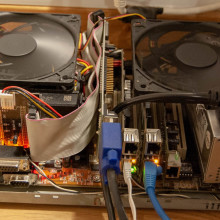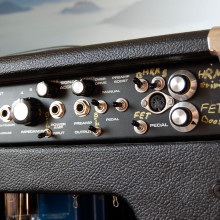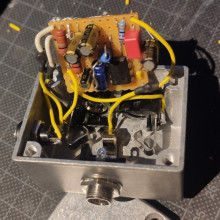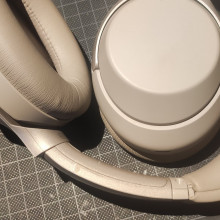Here you’ll find a collection of things that I do, make, say and think. A collection of projects I publshare on other sites online. Including; custom built and designed guitar or Hi-Fi amplifiers and effects, custom PC servers, and rescued, upcycled hardware. Simply a central place to collect what I’m doing with some of my a creative rest at any given time.
If you are in search for my professional information go to >JohannesJohansson.com<
For multiple ways to contact me this >linktree< makes it easy.
Categories
- DIY (23)
- DIY Audio (12)
- DIY Computation (7)
- DIY Misc (5)
Random Posts
-

Restomod Car: 2 Brakes and Suspension
Completely changing the suspension and brakes with oversized parts on this little car can make for a very fun ride and good companion to a […]
-

Dumble Overdrive Special: 3 Mods
Doing a copy of an amp can be a good learning experience, modifying it to suit your needs and taste, however, can be the really […]
-

Homelab: 3 Turning laptops into mini-servers
One of the most common e-waste sources out there is laptops, slower than other computers and often not upgradable, lacking ability to change peripherals, like […]
-

High gain SLO/Ubershall: 1 Intro
The machine, this is the main amp I play and the platform I most try to optimize. Origins in Sloclone, It can be switched between […]
-

Silence your Guitar Amp – Variable Voltage Regulator
Guitarists often find themselves in love with their amps, playing an electric guitar a lot of the time what’s making up your sound is found […]





Dumble Overdrive Special: 3 Mods
Doing a copy of an amp can be a good learning experience, modifying it to suit your needs and taste, however, can be the really rewarding bit. Here I detail added FX loop, footswitchable; dual HRM, with bypass, FETboost, moved gain bias and fet level on back and DC heaters. For a bluesy rock amp this is plenty, new generations of mods are better seen in my high-gain amp.
Starting with the loop, the dumble amplifiers came without an internal effects loop, to use one you’d have to ad an external ‘dumbelator’ loop. These are important since your delay, reverb and similar time-based effects and modulation really do sound best when placed after all the core tone shaping, here happening in the preamp. To add one simply look up a dumbelator schematic and follow for instance a layout named ’97_ODS_HRM_Loop on ampgarage.com . Find a place on the board for some parts and power supply caps as in the first two images, and the last shows the core components and controls around the tube socket. It’s a very capable loop with nice bright switches.
Dual, switchable and bypassable HRM modules, a nice thought I picked up by combining the ideas of separate other builds. As in the original having a Marshall tonestack is great however adding a Fender tonestack with each possible to have set to their own values and have them footswitchable allow for an instant change in feel of the overdrive. To do this I have two boards with their own different brand parts and fitting values, and controlled by a DPDT relay that selects what HRM output to use and removes ground from the module not in use. Having them switchable, I also want to be able to switch out the HRM modules all together and rely more on the main tonestack of the ODS like earlier 70’s versions of the amp. To do this I supplant a 100k and 330pf/500pF combo as in the Two notes ‘Opal’ amplifier.
The switching is also made very flexible (image below) as I, for starters, want additional functionality of the OD switch, to always switch OUT the main tonestack IF a HRM module is selected. Having the tonestack late in the chain gives a more pleasant overdrive sound, and not weighing down the signal by two tonestacks, which is why most people do it this way, by flipping the PAB switch. Using an on/on/on switch on the PAB spot I can have the middle position allow for this behavior and then the other positions as definite off and definite on. Additionally, by breaking this relationship IF HRM bypass is switched, I make sure that the early tonestack IS in place IF the HRM bypass switch has been flipped when set in the middle position. This allow for a partly bypassed HRM stack that still do use the early tonestack, representing the base behavior I (and most users) prefer, but without switching anything and still allowing for absolute on/off of PAB etc. Yet since the pab relay now has two parts to ground the HRM bypass switch also needs to be an on/on/on switch, where the middle positions splits the pair of otherwise parallel switches (indicated by circles around the poles in the image below) .
Having the typical fetboost footswitchable is also a very nice add on, to do this while retaining the two inputs normal/fet on the front took some time to get all leads of the switchcrafts right, but in the end the Normal input will always bypass the Boost, and the FET input is or is not boosted based on a relay. Moving the gainpot to the back is trivial, and as a result a nice built in boost is available much better than the typical PAB “preampboost” switch that is just a tonestack lift, “raw” switch.
Several other tweaks can be done here is some snubber caps on V2 smooths/warms out the tone somewhat, in as they remove treble, which can be tweaked with the next mode.
Treble bleed is a nice thing to have on the OD by itself not influencing the clean sound, keeping it variable also allow for different settings while playing alone, with a drummer or in a full band, where, on a staggered scale, essentially more treble is needed. This ‘bleeds’ treble to ground limited by what range the trimmer pot is set to.
All in all these mods add options to a still core dumble ‘183’ build, and the amp is truly a joy to play, the directness of it as often stated are really true, and it’s ‘bloom’ as well. Notes ‘swell’ by themselves and this really is something else when looking for just enough breakup of tones. Finding all the parts thou, (using period correct and type correct parts) is something of a modern-day treasure hunt, that do deliver!!
The controls are quite cramped,yet mostly this will be used from the footswitch once done. A bit of temporary notations jotted down, one challenge with a black chassis are always that nice waterslide print decals isn’t available.
Left to do is add the hrm bypass to a relay and making it footswitchable, not to mention build a custom footswitch for the 5 options, but thats for part 3.
Dumble Overdrive Special: 1 Head & circuit
Dumble Overdrive Special: 2 Headshell